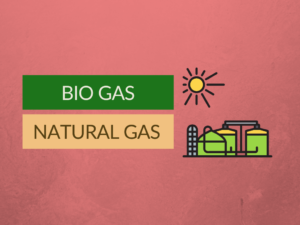The Difference Between Biogas and Natural Gas
Biogas and natural gas are both commonly used as sources of energy. However, there are some key differences between these two types of gases. This article will explore what biogas and natural gas are, provide examples of each, discuss their uses, and highlight the main differences between them.
What is Biogas?
Biogas is a type of gas that is produced through the decomposition of organic matter in the absence of oxygen. It is primarily composed of methane (CH4) and carbon dioxide (CO2), with small amounts of other gases such as hydrogen sulfide (H2S) and nitrogen (N2).
Examples of Biogas
Examples of biogas include gas produced from the anaerobic digestion of agricultural waste, sewage sludge, landfills, and organic materials.
Uses of Biogas
Biogas can be used for various purposes, including:
- Generating electricity through the use of biogas-powered generators
- Producing heat for buildings, cooking, and water heating
- Fueling vehicles, such as cars, buses, and trucks
- Replacing fossil fuels, thus reducing greenhouse gas emissions
What is Natural Gas?
Natural gas is a fossil fuel that is composed mainly of methane (CH4) and small amounts of other hydrocarbon gases. It is formed over millions of years from the remains of plants and animals that were buried and subjected to high pressures and temperatures deep within the Earth.
Examples of Natural Gas
Examples of natural gas include the gas extracted from natural gas wells and reserves found deep underground and the gas associated with oil production.
Uses of Natural Gas
Natural gas has a wide range of uses, including:
- Heating homes, buildings, and water
- Generating electricity in power plants
- Providing fuel for cooking and heating appliances
- Powering vehicles, particularly those that use compressed natural gas (CNG)
Differences between Biogas and Natural Gas
| Difference Area | Biogas | Natural Gas |
|---|---|---|
| Source | Produced from organic waste materials | Formed from decaying plants and animals over millions of years |
| Composition | Mainly methane (CH4) and carbon dioxide (CO2) | Mainly methane (CH4) and small amounts of other hydrocarbon gases |
| Renewability | Renewable, as it is derived from organic waste | Non-renewable, as it takes millions of years to form |
| Production Process | Produced through anaerobic digestion | Extracted from natural gas wells and reserves |
| Emissions | Lower carbon emissions compared to natural gas | Higher carbon emissions due to fossil fuel origin |
| Availability | Dependent on the amount of organic waste produced | Dependent on natural gas reserves and exploration efforts |
| Price | Can be cheaper due to the availability of organic waste materials | Can be affected by market conditions and exploration costs |
| Environmental Impact | Helps reduce greenhouse gas emissions and waste | Contributes to greenhouse gas emissions and climate change |
| Infrastructure | Requires specialized infrastructure for production and distribution | Existing infrastructure for extraction, storage, and distribution |
| Energy Density | Lower energy density compared to natural gas | Higher energy density, providing more energy per volume |
Conclusion
In summary, biogas and natural gas differ in their sources, composition, renewability, production processes, emissions, availability, price, environmental impact, infrastructure requirements, and energy density. Biogas, derived from organic waste, is renewable, has lower carbon emissions, and requires specialized infrastructure. Natural gas, a non-renewable fossil fuel, has higher carbon emissions, availability dependent on reserves, can be affected by market conditions, and has established infrastructure. Ultimately, the choice between biogas and natural gas depends on factors such as sustainability goals, cost considerations, and availability.
People Also Ask
- Is biogas the same as natural gas?
- Is biogas renewable?
- Which gas has lower carbon emissions: biogas or natural gas?
- Can biogas be used as a vehicle fuel?
- What are the environmental benefits of biogas?
No, biogas and natural gas are different. Biogas is produced through the decomposition of organic matter, while natural gas is a fossil fuel formed over millions of years.
Yes, biogas is renewable as it is derived from organic waste materials, which can be continually produced.
Biogas generally has lower carbon emissions compared to natural gas due to its renewable nature and lower methane leakage during production.
Yes, biogas can be used as a vehicle fuel. Vehicles can be modified to use biogas, which can reduce greenhouse gas emissions compared to traditional fossil fuels.
Biogas helps reduce greenhouse gas emissions, reduces dependence on fossil fuels, and promotes the recycling of organic waste materials.


